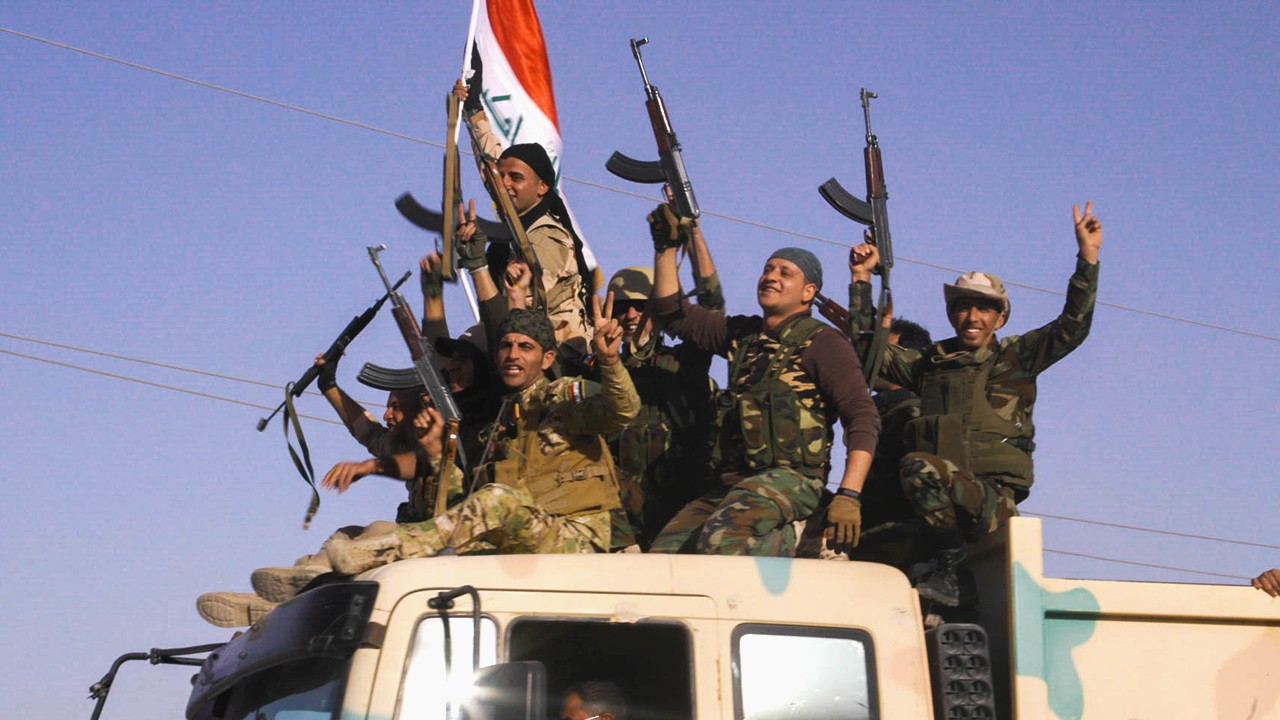Photo courtesy of Cohen Media Group
When it comes to media portrayals of the soldiers fighting ISIS, rarely are female soldiers included. But Girls of the Sun, a film released on April 12, follows a battalion of women fighting terrorism in the Middle East.Girls of the Sun is French director Eva Husson’s latest film, which is inspired by the true story of a group of Kurdish women who were captured by ISIS in Iraq and held hostage in 2014. Some escaped, lived to tell their story, and returned with guns to fight back.“When I learned that some of these women had escaped and were fighting, I felt the story had to be told on the big screen,” Husson tells Broadly. “To understand what they had gone through, from a female perspective, has literally never been done before.” The film dances above a thin line between reality and fiction. The film stars Golshifteh Farahani, an Iranian actress who was banished from the country for appearing topless in a French film back in 2012 (this month, she’s a Vogue cover star). In the film, her character, Bahar, has escaped ISIS captivity and is on a mission to get her son back from her hometown. As the commander of the women army, Bahar's motto is: “Women, life, liberty.”“Farahani is a symbol of freedom and women’s rights; she left Iran because she couldn’t do the films she wanted to do,” says the film’s producer Didar Domehri, who is also an Iranian living in exile. “She wanted to pay homage to these women.”The film follows and is narrated by a French photojournalist named Mathilde (Emmanuelle Bercot), which is loosely based on the late American war correspondent Marie Colvin, who was killed in 2012 while reporting the attacks on Syria. Rather than showing the group as victims, they come across like a fearless gang who hide out in abandoned buildings, ride around in a truck, don dresses, and head scarves while shooting their AK47s.The film is loosely based on the life, too, of Nobel Peace Prize-winning human rights activist Nadia Murad, who was kidnapped by ISIS from her Iraqi hometown in Kocho and held captive for three months, where she was raped and beaten. After escaping when her captor forgot to lock a door, she now runs an organization in Germany to help women and children who have fallen victim to genocide and human trafficking called Nadia’s Initiative.“It moved me to witness the strength of women who refused to be reduced to a victim status,” says Husson. “Murad is a monument of courage.”The film came about after Husson told Domehri about the Kurdi women soldiers. “It was such a ray of light in the darkness, we wanted to do everything to make it happen,” Domerhri says. “We wanted to show how much these women went through; how much resilience is needed to fight back.”Many of the women soldiers today are refugees who live in Germany and France, who the filmmaker met as part of her research. Some of their stories were too gruesome to include in the film. “We couldn’t put them all in the script, you wouldn’t believe what we heard,” Domehri says. “Without showing too much, we wanted to show the violence they went through.”Though the film looks like it was shot in the Middle East, it was shot in the countryside of Georgia, the small country underneath Russia “which looks like Kurdistan,” says Domehri, who helped cast Swedish and German actors for some of the roles.“The characters are based on strong-minded women who were kept slaves and play a huge role not only in the battlefield, but it was a fantastic example to us that gave us hope for all women,” she says. “In the most difficult dark place, you can make it happen if you get organized.”
The film dances above a thin line between reality and fiction. The film stars Golshifteh Farahani, an Iranian actress who was banished from the country for appearing topless in a French film back in 2012 (this month, she’s a Vogue cover star). In the film, her character, Bahar, has escaped ISIS captivity and is on a mission to get her son back from her hometown. As the commander of the women army, Bahar's motto is: “Women, life, liberty.”“Farahani is a symbol of freedom and women’s rights; she left Iran because she couldn’t do the films she wanted to do,” says the film’s producer Didar Domehri, who is also an Iranian living in exile. “She wanted to pay homage to these women.”The film follows and is narrated by a French photojournalist named Mathilde (Emmanuelle Bercot), which is loosely based on the late American war correspondent Marie Colvin, who was killed in 2012 while reporting the attacks on Syria. Rather than showing the group as victims, they come across like a fearless gang who hide out in abandoned buildings, ride around in a truck, don dresses, and head scarves while shooting their AK47s.The film is loosely based on the life, too, of Nobel Peace Prize-winning human rights activist Nadia Murad, who was kidnapped by ISIS from her Iraqi hometown in Kocho and held captive for three months, where she was raped and beaten. After escaping when her captor forgot to lock a door, she now runs an organization in Germany to help women and children who have fallen victim to genocide and human trafficking called Nadia’s Initiative.“It moved me to witness the strength of women who refused to be reduced to a victim status,” says Husson. “Murad is a monument of courage.”The film came about after Husson told Domehri about the Kurdi women soldiers. “It was such a ray of light in the darkness, we wanted to do everything to make it happen,” Domerhri says. “We wanted to show how much these women went through; how much resilience is needed to fight back.”Many of the women soldiers today are refugees who live in Germany and France, who the filmmaker met as part of her research. Some of their stories were too gruesome to include in the film. “We couldn’t put them all in the script, you wouldn’t believe what we heard,” Domehri says. “Without showing too much, we wanted to show the violence they went through.”Though the film looks like it was shot in the Middle East, it was shot in the countryside of Georgia, the small country underneath Russia “which looks like Kurdistan,” says Domehri, who helped cast Swedish and German actors for some of the roles.“The characters are based on strong-minded women who were kept slaves and play a huge role not only in the battlefield, but it was a fantastic example to us that gave us hope for all women,” she says. “In the most difficult dark place, you can make it happen if you get organized.”
Advertisement

Advertisement
Even behind-the-scenes, the film honors women—the filmmaking team had a cast of women who helped get the film off the ground, like Domehri and Adeline Fontan-Tessaur, who helped get the film to an international audience, and the casting director Bahijja El Amrani, who scouted in seven countries to find the right Kurdish cast.The film details the 15-month battle endured by the Girls of the Sun, and marks what Husson calls “the beginning of the end for the Islamic State in Iraq.” It also signals the change in the Middle East, where more women are rising to prominence in politics.“An unequal society is a sick society,” Husson says. “We’re far from living in equal societies, so fighting, resisting, wherever it is, sorority, inclusion, they’re beneficial to all of us. We can’t possibly be satisfied with the crumbs. When things get better for women, they get better for everyone.”
